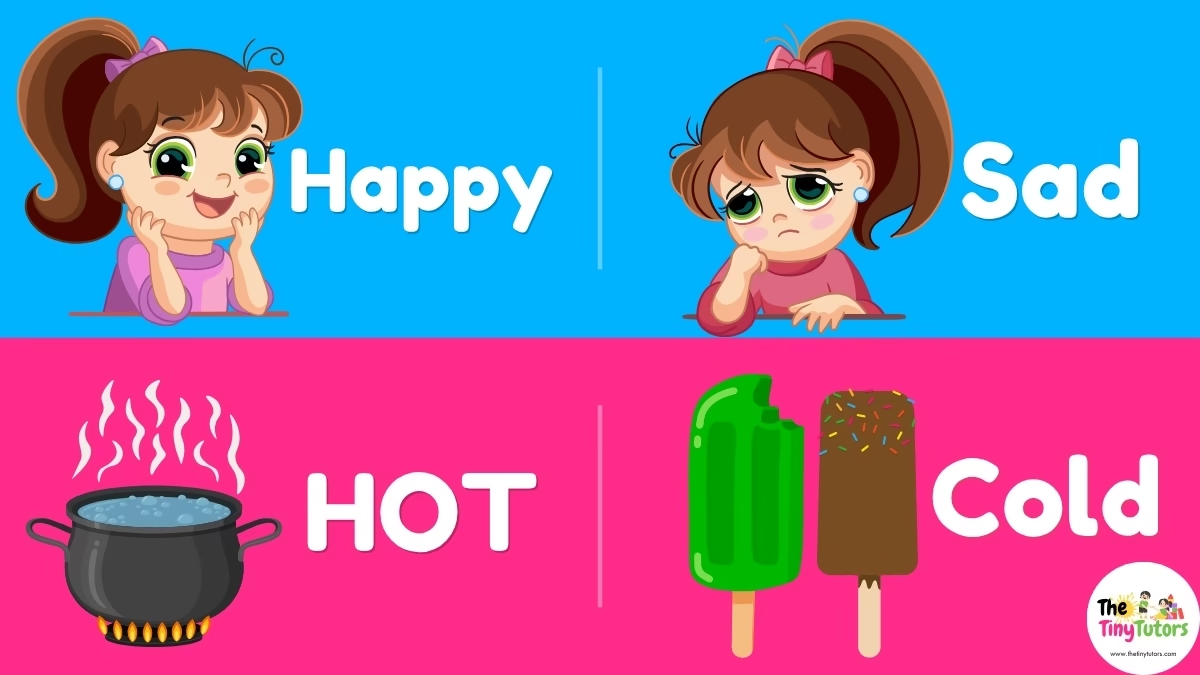Learning opposite words for kids is an exciting journey that opens up a whole new world of understanding. When kids begin to explore opposites, they quickly realize how different things can be from one another. This discovery makes the world feel more vibrant and full of possibilities. Learning opposite words for kids doesn’t just help them build a bigger vocabulary, it also gives them the chance to use these words in real-life situations. For instance, when they talk about the weather, they can say things like “hot” and “cold,” which makes their conversations more fun and engaging.
Why is learning opposite words for kids so important? Well, teaching opposites is much more than simply adding new words to a child’s vocabulary. It’s about helping them recognize and appreciate the differences in the world around them. When kids learn words like “big” and “small,” they start to comprehend the size of things in a clearer way. This understanding makes it easier for them to explain and describe things in their everyday lives. Whether they’re talking about their favorite toys or the animals they see at the zoo, knowing opposite words for kids helps them communicate with confidence.
Additionally, learning opposite words for kids is a fantastic way to develop their thinking skills. Opposites encourage children to think critically and grasp how different things are related. For example, when kids learn the opposite of “up” is “down,” they understand spatial relationships better, which can even help them when learning other subjects like math or science. By practicing opposites, children also learn to recognize contrasts and see the world in a new way, boosting their creativity.
Read more: Good Habits and Bad Habits for Kids 2025: Fun Guide to Healthy Life
Understanding opposites plays a key role in helping children grasp emotions more clearly. When kids learn the contrast between words like “happy” and “sad,” it becomes easier for them to identify and express their own feelings. The more familiar they become with opposites, the more confidently they can communicate their emotions. Whether they’re describing their day at school or talking about their favorite ice cream flavor, opposites help children make sense of the world.
Ultimately, exploring opposite words is a fun and effective way for children to grow their vocabulary and enhance their ability to communicate. The more they practice opposites, the more they’ll be able to express themselves clearly and confidently. By making this journey fun and engaging, we help kids see the many differences that make the world around them so fascinating!
Big & Small
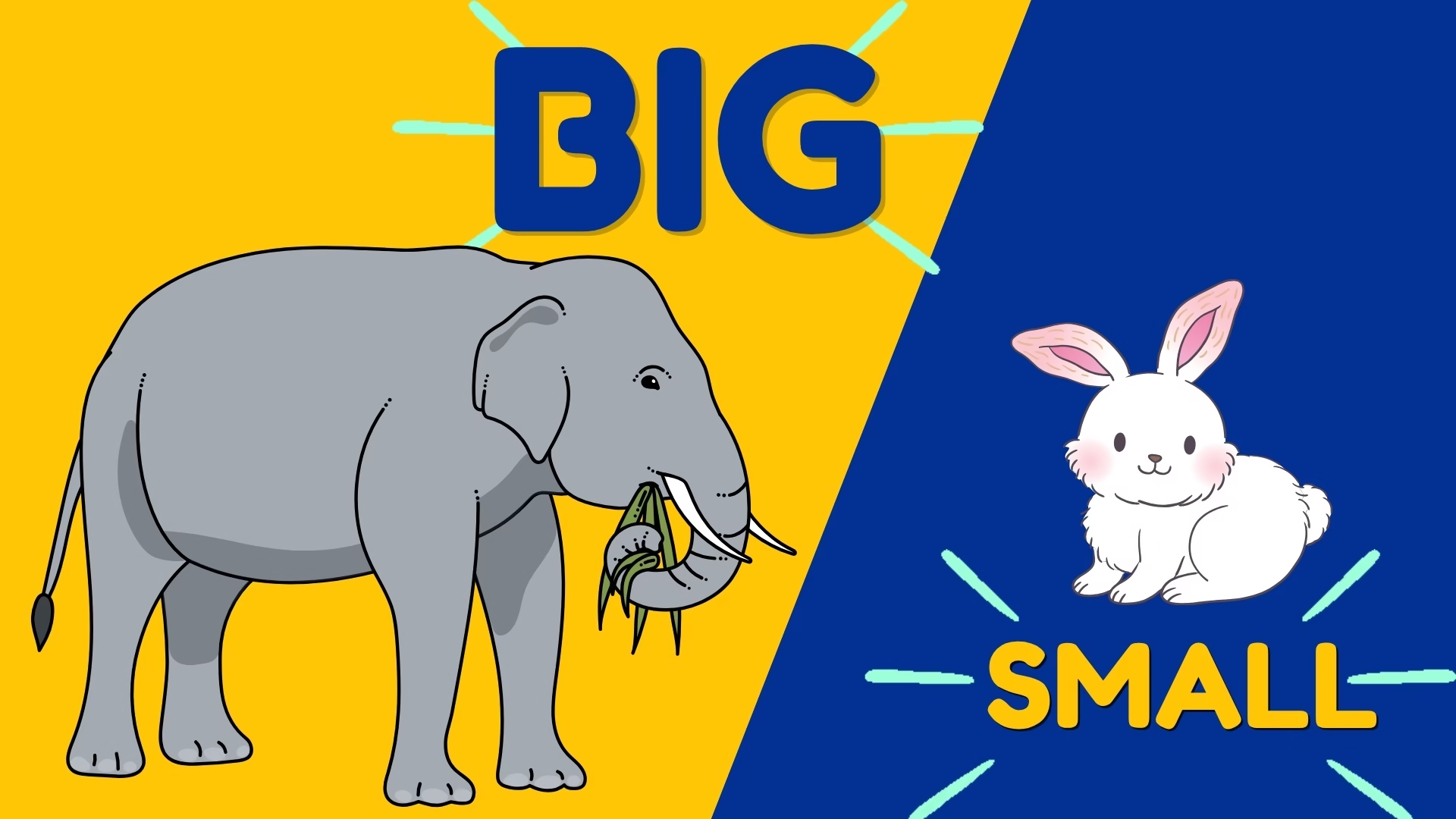
Big and small are two opposite words that help kids understand the concept of size. For instance, an elephant is a great representation of something large—it’s massive and occupies a lot of space! On the other hand, a rabbit is small and tiny, making it a great example of something small. These two opposites help kids see how different things can be when it comes to size.
Real-Life Example:
Imagine you have a backpack. If it’s big, it might be full of books, toys, or snacks. But if your backpack is small or empty, it means you don’t have anything inside. By practicing opposite words for kids, like big and small, children can easily grasp the difference between these sizes in their everyday lives.
Small Story:
Did you know that elephants are so big they can use their trunks like a hand? They can pick up things, drink water, and even greet other elephants with their trunks! Isn’t that amazing? And although elephants are big, a rabbit is so small that it can hop around easily and fit into small spaces, like under a bush or into a little burrow!
Rhyming Fun:
Big and small, short and tall.
See the elephant, hear the call!
Hop like a rabbit, tiny and small,
Big or small, we love them all!
Fast & Slow
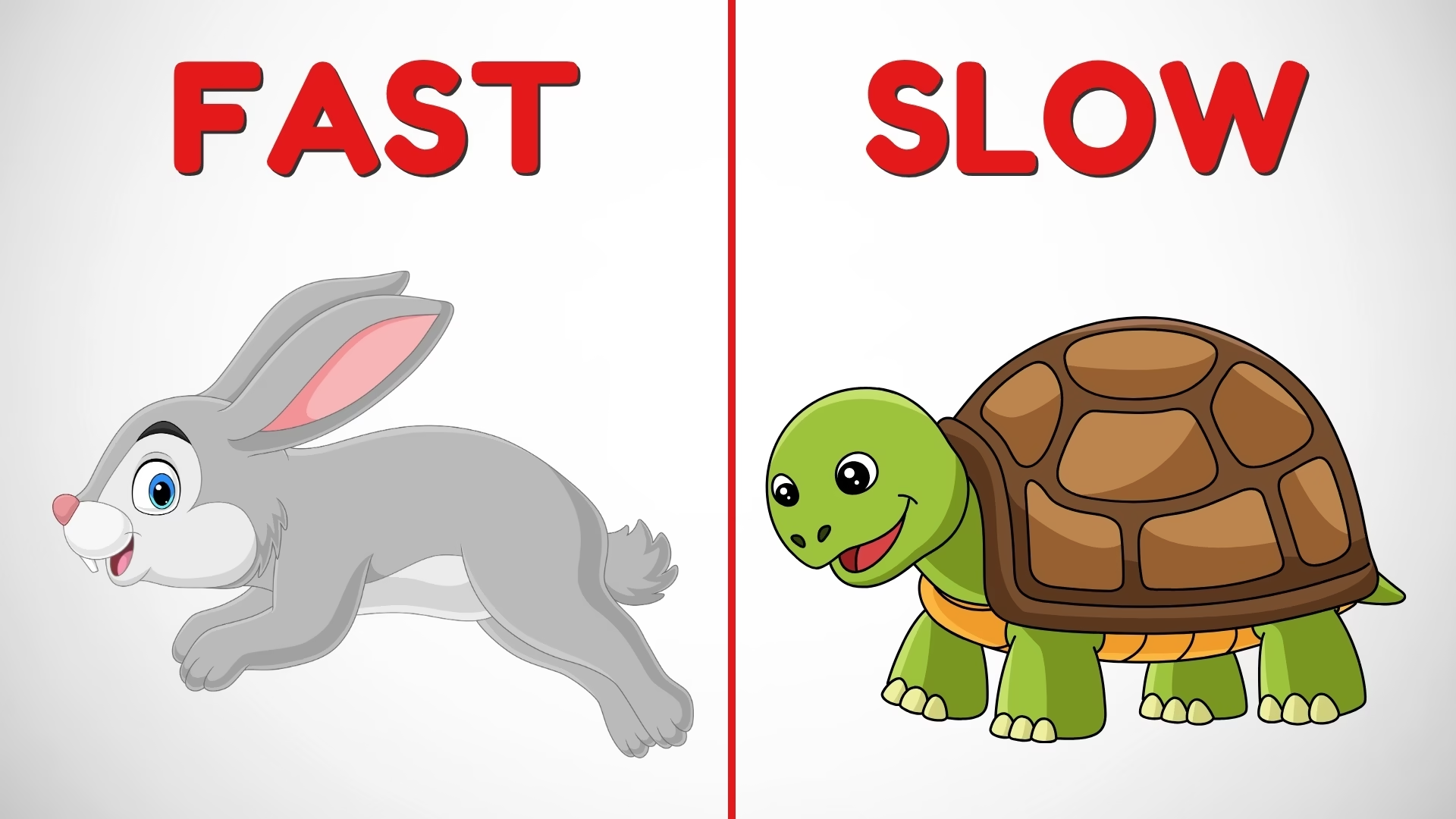
Another set of opposites that help kids learn about speed are fast and slow. For example, rabbits are widely known for their fast movement. It hops quickly across the field. On the other hand, the tortoise is slow and moves at a much more relaxed pace. These two opposites show how things can move differently, helping kids understand the concept of speed.
Real-Life Example:
Imagine having a race with your friend. If you run fast, you’re like the rabbit who hops quickly. But if you decide to take a walk, you move like the tortoise, slow and steady. Understanding these opposite words for kids helps them understand how speed works in a fun and practical way!
Small Story:
Are you aware of the famous fable called “The Tortoise and the Hare”? The hare sprinted ahead, sure it would easily claim victory. However, it decided to take a nap along the way. Meanwhile, the tortoise continued steadily and without pause. In the end, the tortoise won because it never stopped moving! This story shows us that sometimes slow and steady progress is the key to success.
Rhyming Fun:
Fast and slow, we love to go!
Rabbit runs, tortoise takes it slow.
Hop and jump, or take a stroll,
Both are fun, they make us whole!
Full & Empty
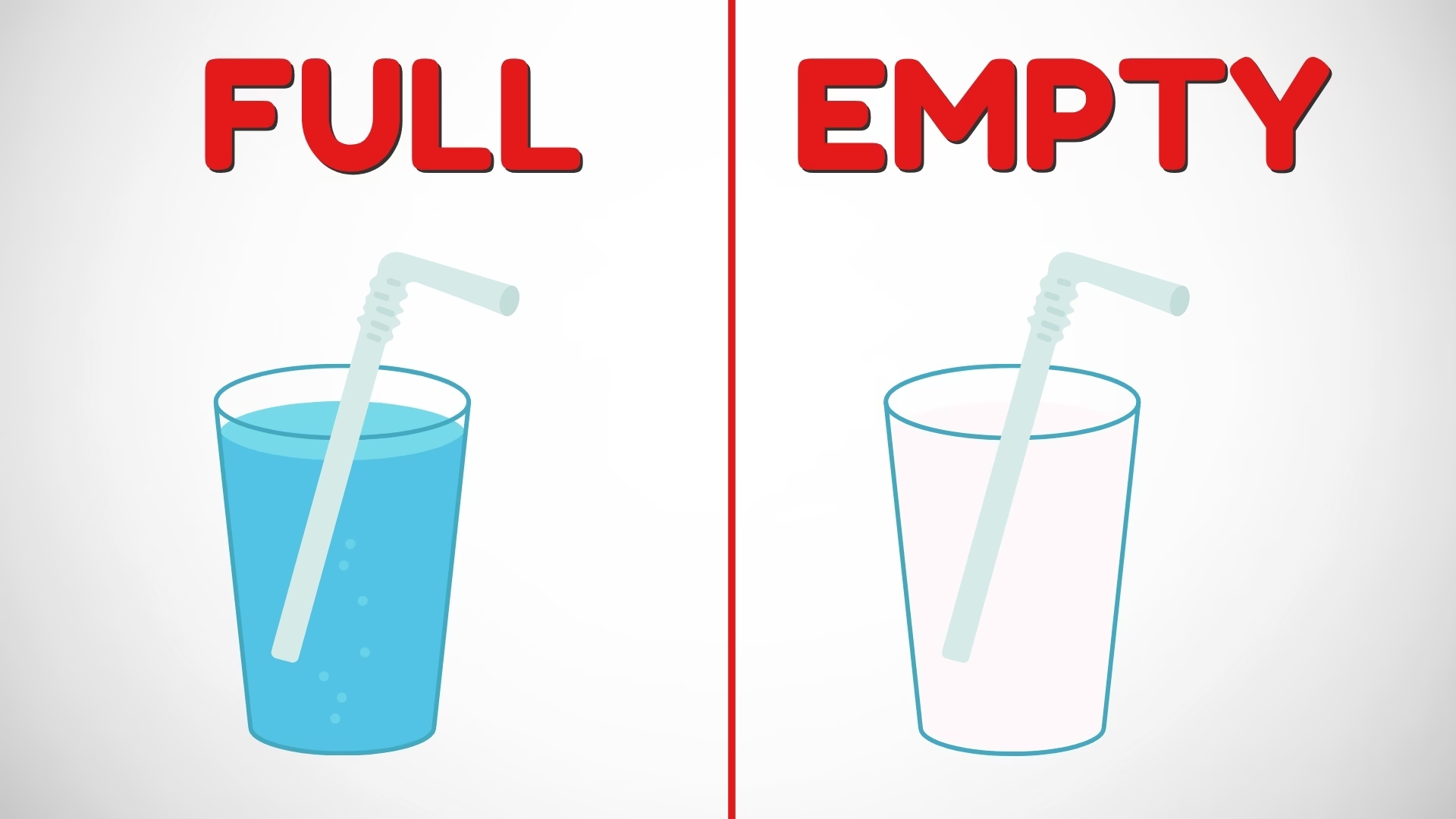
Full and empty are great opposite words for kids to learn! They help children understand whether something has anything inside or not. Imagine you have a glass. When it’s filled with juice, it’s full. But when you drink it all, the glass becomes empty. These simple and enjoyable words assist children in talking about common things they encounter daily.
Real-Life Example:
Think about your school backpack. A full backpack means you’ve packed your books, lunch, and even your favorite toy. But an empty backpack? That means it’s all cleaned out—nothing inside! Learning opposite words for kids like full and empty helps them understand what’s around them and describe what they see or feel.
Small Story:
One day, Emma had a full glass of water. She took a big sip, then another—and before she knew it, the glass was empty! She smiled and asked for more. Can you think of other things that can be full or empty? Maybe your snack bowl, a toy bin, or even your tummy!
Rhyming Fun:
Full or empty, there’s so much to see!
The glass holds juice, but my cup’s empty.
A bowl filled with fruit, a plate with no treat,
When it’s empty, mealtime’s complete!
Visit our channel: Opposite Words in English | Fun Learning for Kids & Toddlers
Happy & Sad
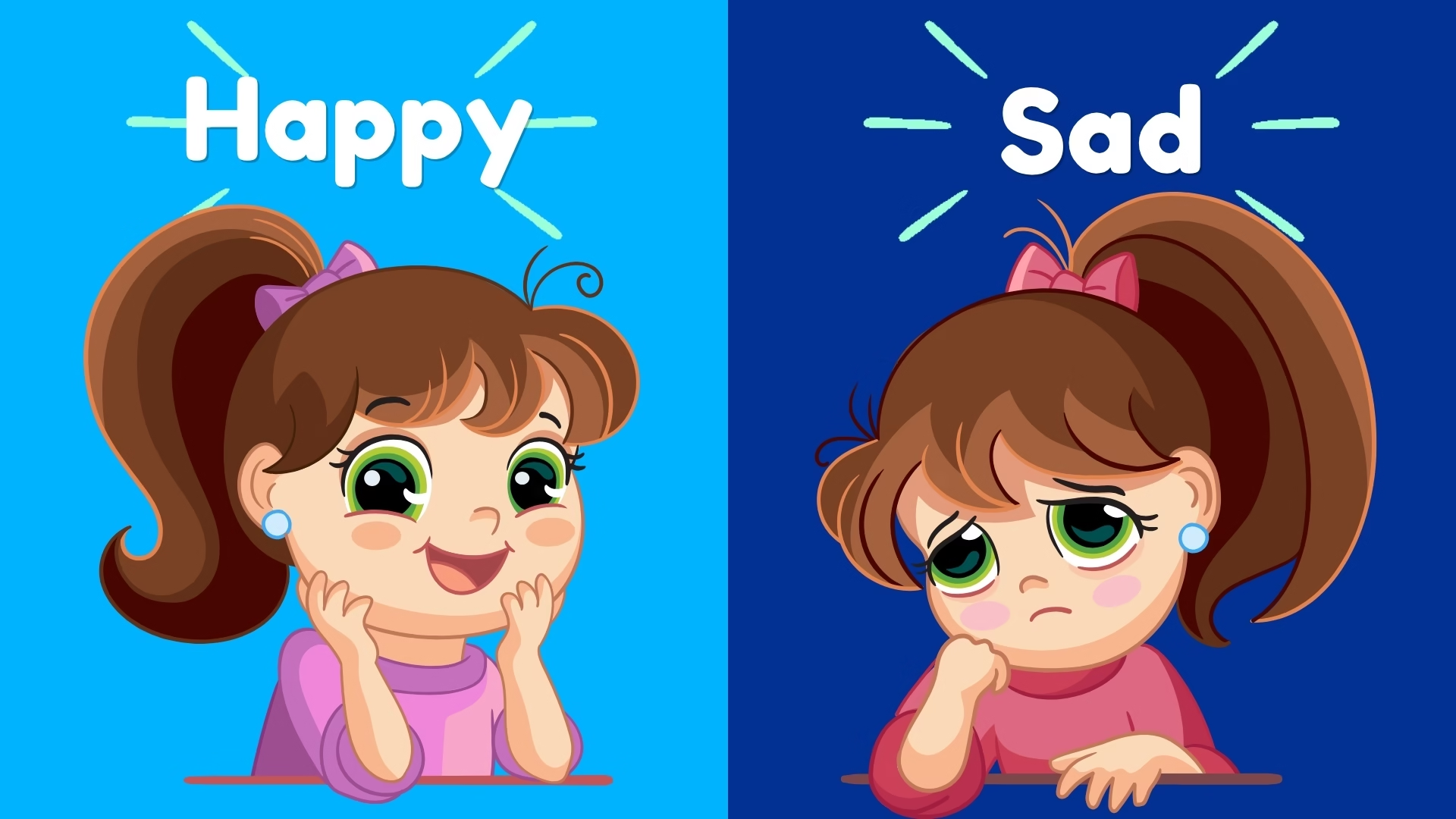
Happy and sad are wonderful opposite words for kids to help them explore their emotions. When you’re happy, you laugh, smile, and feel good inside. But when you’re sad, your face might frown, and you may want a hug. These opposite feelings help kids learn how to express themselves in the best way.
Real-Life Example:
If your friend shares their toy, you feel happy! But if you lose your favorite stuffed animal, you might feel sad. Learning opposite words for kids like happy and sad helps children talk about their emotions and understand what others might be feeling too.
Small Story:
Did you know that smiling can trick your brain into feeling more happy? It’s true! Even if you’re feeling a little sad, try a smile—it might just turn your day around. That’s the power of learning about opposite words for kids and how they apply to real life!
Rhyming Fun:
Happy and sad, feelings we’ve had,
Smiles are bright, frowns aren’t bad.
It’s okay to feel happy or blue,
All your feelings belong to you!
Hot & Cold
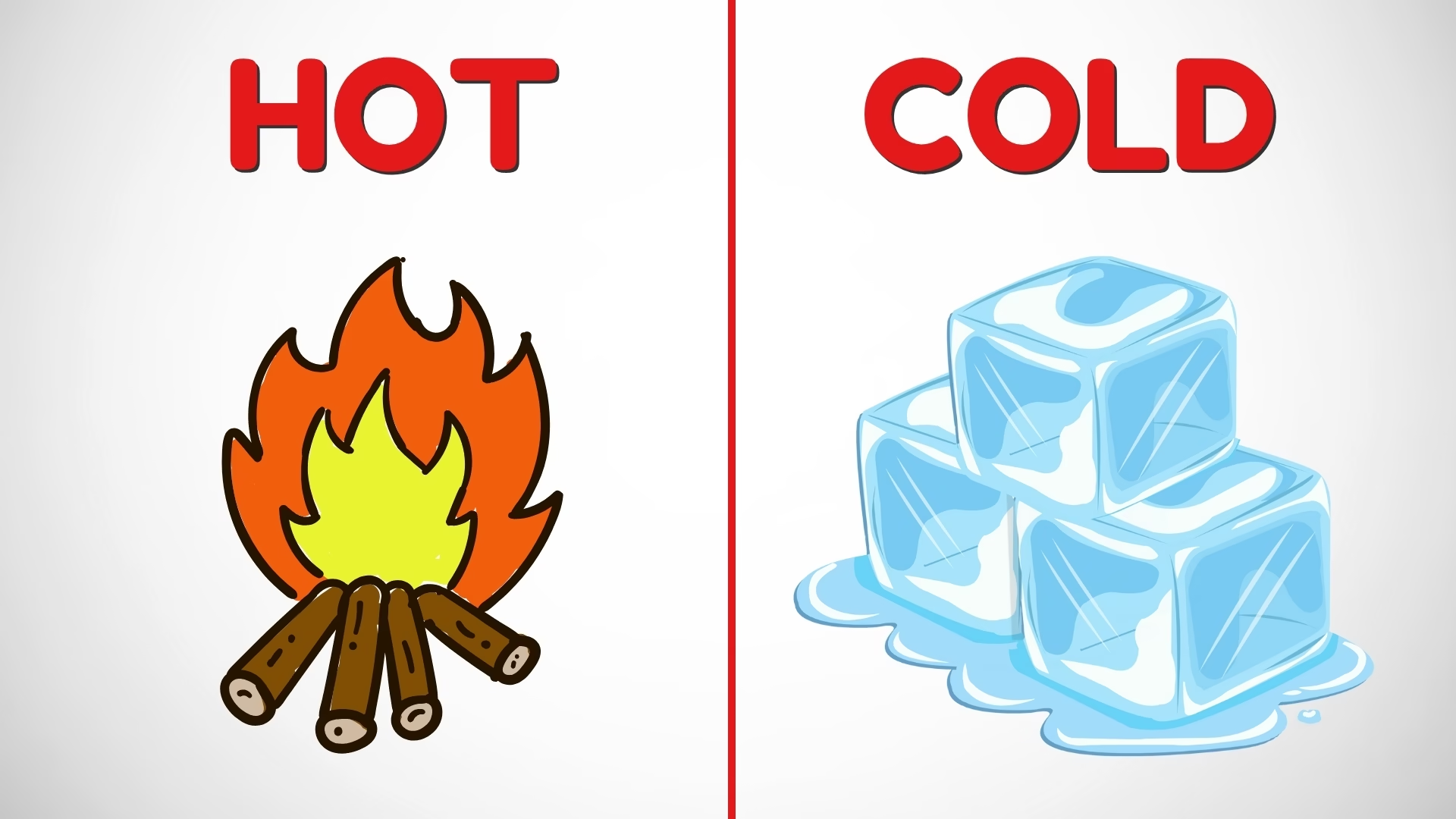
Hot and cold are enjoyable and well-known opposite words for kids. We feel them every day—when we touch food, feel the weather, or even sip our drinks. Hot things, like the sun or a fire, can make us warm. Cold things, like snow or ice cubes, can make us shiver!
Real-Life Example:
On a hot summer day, you might want a cold ice cream cone to cool off. In the winter, when it’s cold, you might cuddle up under a blanket with some hot cocoa. These experiences help kids learn opposite words for kids through real-life moments that are easy to understand and relate to.
Small Story:
One chilly day, Liam dropped ice cubes into a mug of hot tea. The ice cubes started to melt! “Wow!” he said. “The hot tea made the cold ice disappear!” He learned that opposites can work together in surprising ways. That’s why exploring opposite words for kids can be so exciting.
Rhyming Fun:
Hot and cold, so young and old,
Fire is warm, ice is bold.
Cold as snow or hot like flame,
Opposites make life a fun game!
Good & Bad
Good and bad are important opposite words for kids that teach more than just language—they help children understand right from wrong. Doing good things like helping a friend or saying kind words makes others feel happy. But doing bad things like yelling or breaking toys can hurt someone’s feelings.
Real-Life Example:
Helping your little brother pick up his crayons is a good choice. Taking toys without asking is a bad one. Learning these opposite words for kids helps children make thoughtful and kind decisions every day.
Small Story:
One day, Mia saw her classmate drop a lunchbox. She rushed to help pick it up. But the next day, Mia yelled in class. “That behavior was bad, Mia,” her teacher said gently. “Let’s always try to be kind.”
Rhyming Fun:
Good and bad, happy or mad,
Be kind each day—it makes hearts glad!
Learning opposite words for kids like good and bad helps them become more thoughtful, caring, and confident in how they treat others.
Strong & Weak
Strong and weak are great opposite words for kids that help describe how much strength or energy someone has. When you feel strong, you can lift, run, and play. But when you’re tired, your body needs rest and care.
Real-Life Example:
After a healthy meal and good sleep, you feel strong! if you’re feeling unwell or exhausted, you might feel weak and require some assistance. These opposite words for kids help children understand how their bodies feel.
Small Story:
Liam loved pretending to be a superhero, lifting toy boxes and running fast. “I’m so strong!” he cheered. But one day, when he had a cold, he could barely lift his teddy bear. “I feel weak,” he whispered. Learning these opposite words for kids helps kids talk about how they’re feeling inside and out.
Rhyming Fun:
Strong and weak, hide and seek,
When you’re strong, you shout and speak!
Rich & Poor
Rich and poor are opposite words for kids that help explain the difference between having more and having less. A rich person might have many toys or treasures, while a poor person may have only a few.
Real-Life Example:
A child with a big shelf full of toys may be rich in things. But a child with just one special toy can be rich in love. Teaching opposite words for kids like rich and poor also opens the door to lessons about sharing and kindness.
Small Story:
A little boy had only one toy car. His friend had many toys. “You must be rich!” he said. The friend grinned and said, “You’re always so good at sharing with me.” That makes you rich in friendship too!”
Rhyming Fun:
Rich and poor, less or more,
What we give is worth much more!
Day & Night
Day and night are some of the easiest and most magical opposite words for kids to learn. Day is when the sun shines, and you play outside. Night is when stars sparkle, and it’s time to rest.
Real-Life Example:
Children attend school in the day time and rest at night. These opposite words for kids help children understand routines and how the world changes with time.
Small Story:
Emma loved the day—bike rides, sunshine, and snacks! But at night, she would look at stars and tell stories with her dad. “The night is just as fun,” she smiled. Through opposites like day and night, children learn about nature and time.
Rhyming Fun:
Day and night, dark and light,
Sun is bright, moon is white!
Love & Hate
Love and hate are powerful feelings and important opposite words for children to understand. Love means caring deeply, while hate means not liking something a lot. Understanding these feelings helps kids grow emotionally and talk about how they feel.
Real-Life Example:
You feel love when your puppy jumps into your lap. You might feel hate when someone breaks your toy. Learning opposite words for kids like these teaches children to understand and manage big emotions.
Small Story:
Sophie loved her doll. When her brother broke it, she shouted, “I hate you!” Later, she felt sorry and hugged him. “I was just really upset,” she said. They fixed the doll together. That’s what love does—it forgives and heals.
Rhyming Fun:
Love and hate, early or late,
Choose love each day—it’s never too late!

